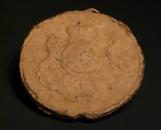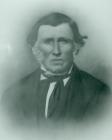14
Seal from the Pettit Farm Deed19th Century, Circa 1802
Grimsby, Ontario, Canada
 Credits:
Credits:Grimsby Museum Collection
15
Another grandson, Andrew Hamilton Pettit, cultivated a farm nearby that was known for its excellent tender fruit and his advanced methods of shipping this fruit overseas. Andrew Hamilton Pettit also represented the Government of Ontario at the Chicago World's Fair in 1893 when Canadian fruit won four times as many awards as any other country.Andrew Pettit, the original settler, was also joined by his brothers, John, Nathaniel, Charles and their families, who made the journey to the area as Loyalists. Nathaniel, because of his great losses as a Loyalist, was granted two thousand acres across five townships including Grimsby and Saltfleet (now Stoney Creek).
16
THE NELLES FAMILYAs an officer with the British Troops during the American Revolution, Hendrick (Henry) William Nelles was worried about his family and sent them to Upper Canada. Henry petitioned General Haldimand for land in Upper Canada as compensation for the extensive losses that he had incurred during the war. This included a three hundred acre farm on the Mohawk River and four additional one hundred acre farms with livestock and farm equipment.
As payment for these losses Henry was given five lots in Grimsby Township and land along the Grand River. His sons Robert, William, Warner and Abraham settled in Grimsby and worked the land until their deaths in the 1840's and 1850's.
17
Painting of the Hermitage19th Century, Circa 1800
Grimsby, Ontario, Canada
 Credits:
Credits:Grimsby Museum Collection
18
The Barn at the Hermitage19th Century, Circa 1800
Grimsby, Ontario, Canada
 Credits:
Credits:Grimsby Museum Collection
19
The Nelles family was prominent and many generations have lived in Grimsby. Some early Nelles homes with heritage designation are still standing in Grimsby. Two roads and a school bear the Nelles name.20
THE SMITH FAMILY AND THE SMITH TWO CENTURY FARMJohn Smith, born in 1754, came to The Forty (Grimsby) in 1787 with his wife Hannah Wilcox and a group of other Loyalists from New Jersey. As soon as John and Hannah arrived, they built a log cabin and began planting crops including wheat, oats, flax, fruits and vegetables and later apple orchards. John Smith received his Crown Grant in 1804.
22
John Smith had two sons who inherited the farm after their father's death in 1826 (John Wilcox 1800-1876 and Ezekiel 1802 -1886). Ezekiel's son Sardis eventually became owner of his father's half. It is said that at one time Sardis took five bushels of apples to the Hamilton market and came home with a pair of shoes and a suit. Sardis not only grew apples but also packed and shipped them overseas in competition with his cousin E. D. Smith of Winona.When Sardis died his son Robert inherited the farm and today his grandsons Donald and Duncan operate the farm. This farm known as the Smith Two Century farm has seen six generations of Smiths overseeing its operation. Currently the farm covers eighty-five acres and produces peaches, cherries, plums, grapes and nectarines. It is one of the few active two century farms remaining in Ontario.
23
Silas Smith (1756-1844), brother of the first John Smith also came from New Jersey in 1787 with his wife Esther Smith. They were granted land in Saltfleet Township (now Winona and Stoney Creek). One of their children Ananias Smith also worked the family farm.24
Portrait of Ananias Smith19th Century, Circa 1845
Saltfleet Township, Ontario, Canada
 Credits:
Credits:Donated by the Niagara Fruit Institute
Grimsby Museum Collection
25
Senator E.D. Smith was a great-grandson of Esther and Silas. The history of the E. D. Smith Company can be found in the section highlighting the preserving and nursery businesses.26
THE KITCHEN FAMILYWilliam Whitney Kitchen was born in 1824 in Brant County. After living in Iowa, USA he returned to Canada in 1858 and settled in Grimsby. His large farm, known as 'Pleasant Grove', included an orchard and vineyard and was located just west of St. Andrew's Anglican Church. In 1864 W.W. Kitchen opened one of the first wineries in Canada with Jonathan Robbins Pettit as joint owner. This winery used grapes from both the Kitchen and Pettit farms and rhubarb grown on the property. In the "Canadian Almanac" of 1866, Kitchen advertised his Pure Grape Wine.
27
Advertisement for W. W. Kitchen's Pure Grape Wine19th Century, Circa 1864
Grimsby, Ontario, Canada
 Credits:
Credits:Grimsby Museum Collection
